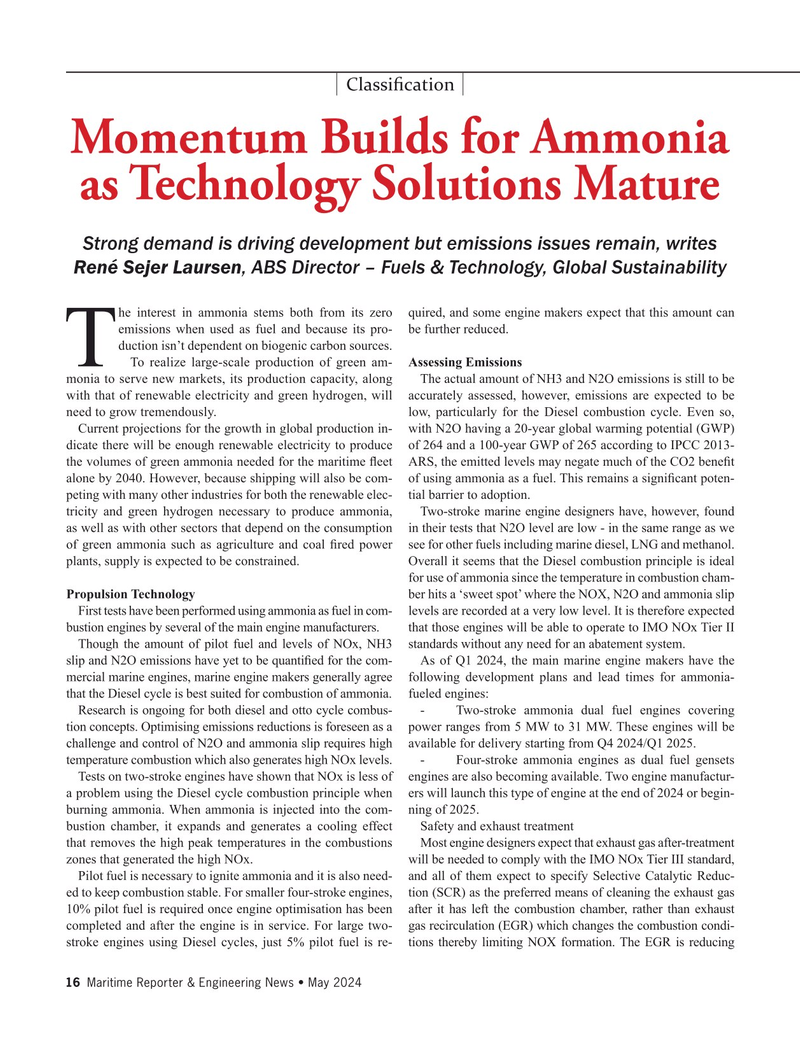
Page 16: of Maritime Reporter Magazine (May 2024)
Read this page in Pdf, Flash or Html5 edition of May 2024 Maritime Reporter Magazine
Classi? cation
Momentum Builds for Ammonia as Technology Solutions Mature
Strong demand is driving development but emissions issues remain, writes
René Sejer Laursen, ABS Director – Fuels & Technology, Global Sustainability he interest in ammonia stems both from its zero quired, and some engine makers expect that this amount can emissions when used as fuel and because its pro- be further reduced. duction isn’t dependent on biogenic carbon sources.
T To realize large-scale production of green am- Assessing Emissions monia to serve new markets, its production capacity, along The actual amount of NH3 and N2O emissions is still to be with that of renewable electricity and green hydrogen, will accurately assessed, however, emissions are expected to be need to grow tremendously. low, particularly for the Diesel combustion cycle. Even so,
Current projections for the growth in global production in- with N2O having a 20-year global warming potential (GWP) dicate there will be enough renewable electricity to produce of 264 and a 100-year GWP of 265 according to IPCC 2013- the volumes of green ammonia needed for the maritime ? eet ARS, the emitted levels may negate much of the CO2 bene? t alone by 2040. However, because shipping will also be com- of using ammonia as a fuel. This remains a signi? cant poten- peting with many other industries for both the renewable elec- tial barrier to adoption. tricity and green hydrogen necessary to produce ammonia, Two-stroke marine engine designers have, however, found as well as with other sectors that depend on the consumption in their tests that N2O level are low - in the same range as we of green ammonia such as agriculture and coal ? red power see for other fuels including marine diesel, LNG and methanol. plants, supply is expected to be constrained. Overall it seems that the Diesel combustion principle is ideal for use of ammonia since the temperature in combustion cham-
Propulsion Technology ber hits a ‘sweet spot’ where the NOX, N2O and ammonia slip
First tests have been performed using ammonia as fuel in com- levels are recorded at a very low level. It is therefore expected bustion engines by several of the main engine manufacturers. that those engines will be able to operate to IMO NOx Tier II
Though the amount of pilot fuel and levels of NOx, NH3 standards without any need for an abatement system. slip and N2O emissions have yet to be quanti? ed for the com- As of Q1 2024, the main marine engine makers have the mercial marine engines, marine engine makers generally agree following development plans and lead times for ammonia- that the Diesel cycle is best suited for combustion of ammonia. fueled engines:
Research is ongoing for both diesel and otto cycle combus- - Two-stroke ammonia dual fuel engines covering tion concepts. Optimising emissions reductions is foreseen as a power ranges from 5 MW to 31 MW. These engines will be challenge and control of N2O and ammonia slip requires high available for delivery starting from Q4 2024/Q1 2025. temperature combustion which also generates high NOx levels. - Four-stroke ammonia engines as dual fuel gensets
Tests on two-stroke engines have shown that NOx is less of engines are also becoming available. Two engine manufactur- a problem using the Diesel cycle combustion principle when ers will launch this type of engine at the end of 2024 or begin- burning ammonia. When ammonia is injected into the com- ning of 2025. bustion chamber, it expands and generates a cooling effect Safety and exhaust treatment that removes the high peak temperatures in the combustions Most engine designers expect that exhaust gas after-treatment zones that generated the high NOx. will be needed to comply with the IMO NOx Tier III standard,
Pilot fuel is necessary to ignite ammonia and it is also need- and all of them expect to specify Selective Catalytic Reduc- ed to keep combustion stable. For smaller four-stroke engines, tion (SCR) as the preferred means of cleaning the exhaust gas 10% pilot fuel is required once engine optimisation has been after it has left the combustion chamber, rather than exhaust completed and after the engine is in service. For large two- gas recirculation (EGR) which changes the combustion condi- stroke engines using Diesel cycles, just 5% pilot fuel is re- tions thereby limiting NOX formation. The EGR is reducing 16 Maritime Reporter & Engineering News • May 2024
MR #5 (1-17).indd 16 5/3/2024 9:52:47 AM

 15
15

 17
17
